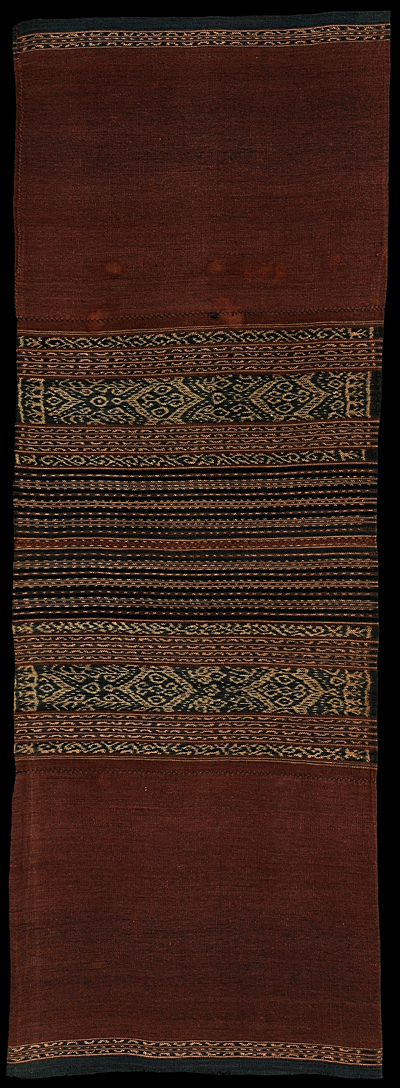| |
 
 | | | |
156 Timor, West Timor
Tais feto (sarong)  
| | Locale: | Malaka. The motifs match both the Malaka and the Insana vernacular, but given the morinda end panels it was most likely made by Tetun people on the Malaka side of the border. | | Period: | Circa 1880 | | Yarn: | Cotton, hand-spun, medium | | Technique: | Warp ikat | | Panels: | 4 | | Size: | 58.5 x 168 cm (1' 11" x 5' 6") LW: 2.87 | | Weight: | 770 g (27.2 oz), 392 g/m2 (1.28 oz/ft2) | | Design: | The main ikated bands are decorated with motifs that appear to be a variant of the ubiquitous kaif motif that stands for relationship with the ancestors. They resemble those used on old sarongs from Kisar of what we call the 'formal type', made by the Meher people, on sarongs from Babar and Luang, and on old Bentenan sarongs from Sulawesi. This is not mentioned to imply that this sarong could come from any of these regions, just to point out the wide distribution of this type of motif. | | Comment: | [PHOTOGRAPHY PROVISIONAL] All natural dyes. Microscopy shows brittle old yarn, with filaments breaking in all directions. The reverse side has a 3 x 4 hole in one of the main ikated bands with an ancient looking patch of darning in handspun indigo yarn, as well as a smaller hole on the edge of one of the plain areas. Four slightly paled spots on the plain panel of the shown side. The overall appearance is that of an old cloth, well used, with colours that are still deeply saturated. The dating given is felt to be conservative. | | Background: | Chapters on Timor and West Timor. | | Exhibited: | Timor: Totems and Tokens, Museu do Oriente, Lisbon, 2019/20. | | Published: | Timor: Totems and Tokens, 2019.
| | Compare: | 274 276 | | Sources: | Very similar to mid century tais feto from Insana in Hamilton and Barrkman, Textiles of Timor, Fig. 2.43, except for the different colour of the plain bands: indigo versus reddish purple. Similar to Malaka tais feto, also 4-panel, in Yeager and Jacobson, Textiles of Western Timor, Plate 214, but without the buna. Similar to sarong from Nunpoi, Malaka, in collection Julie Emery. Compare motif with circa 1900 Kisar homnon in Khan-Majlis, Indonesische Textilien, Fig. 500; circa 1900 Kisar hita, belt, on Fig. 489; Luang lavre, sarong on Fig. 541; Babar lavre, sarong, on Fig. 569 and 567. | | |

©Peter ten Hoopen, 2024
All rights reserved.
|
|


